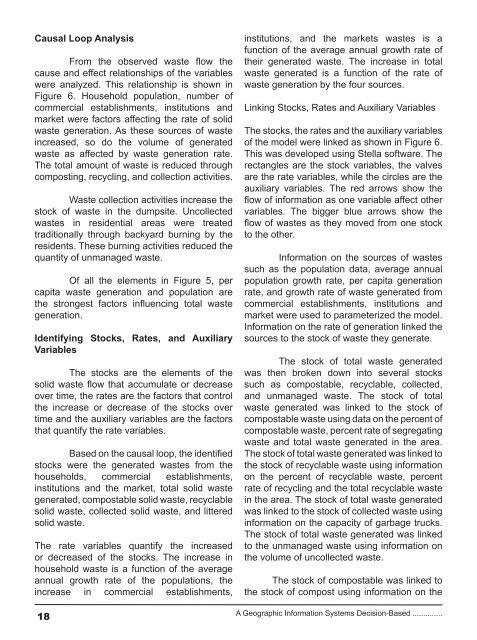download the full article here - EISRJC
download the full article here - EISRJC
download the full article here - EISRJC
You also want an ePaper? Increase the reach of your titles
YUMPU automatically turns print PDFs into web optimized ePapers that Google loves.
Causal Loop Analysis<br />
From <strong>the</strong> observed waste flow <strong>the</strong><br />
cause and effect relationships of <strong>the</strong> variables<br />
were analyzed. This relationship is shown in<br />
Figure 6. Household population, number of<br />
commercial establishments, institutions and<br />
market were factors affecting <strong>the</strong> rate of solid<br />
waste generation. As <strong>the</strong>se sources of waste<br />
increased, so do <strong>the</strong> volume of generated<br />
waste as affected by waste generation rate.<br />
The total amount of waste is reduced through<br />
composting, recycling, and collection activities.<br />
Waste collection activities increase <strong>the</strong><br />
stock of waste in <strong>the</strong> dumpsite. Uncollected<br />
wastes in residential areas were treated<br />
traditionally through backyard burning by <strong>the</strong><br />
residents. These burning activities reduced <strong>the</strong><br />
quantity of unmanaged waste.<br />
Of all <strong>the</strong> elements in Figure 5, per<br />
capita waste generation and population are<br />
<strong>the</strong> strongest factors influencing total waste<br />
generation.<br />
Identifying Stocks, Rates, and Auxiliary<br />
Variables<br />
The stocks are <strong>the</strong> elements of <strong>the</strong><br />
solid waste flow that accumulate or decrease<br />
over time, <strong>the</strong> rates are <strong>the</strong> factors that control<br />
<strong>the</strong> increase or decrease of <strong>the</strong> stocks over<br />
time and <strong>the</strong> auxiliary variables are <strong>the</strong> factors<br />
that quantify <strong>the</strong> rate variables.<br />
Based on <strong>the</strong> causal loop, <strong>the</strong> identified<br />
stocks were <strong>the</strong> generated wastes from <strong>the</strong><br />
households, commercial establishments,<br />
institutions and <strong>the</strong> market, total solid waste<br />
generated, compostable solid waste, recyclable<br />
solid waste, collected solid waste, and littered<br />
solid waste.<br />
The rate variables quantify <strong>the</strong> increased<br />
or decreased of <strong>the</strong> stocks. The increase in<br />
household waste is a function of <strong>the</strong> average<br />
annual growth rate of <strong>the</strong> populations, <strong>the</strong><br />
increase in commercial establishments,<br />
18<br />
institutions, and <strong>the</strong> markets wastes is a<br />
function of <strong>the</strong> average annual growth rate of<br />
<strong>the</strong>ir generated waste. The increase in total<br />
waste generated is a function of <strong>the</strong> rate of<br />
waste generation by <strong>the</strong> four sources.<br />
Linking Stocks, Rates and Auxiliary Variables<br />
The stocks, <strong>the</strong> rates and <strong>the</strong> auxiliary variables<br />
of <strong>the</strong> model were linked as shown in Figure 6.<br />
This was developed using Stella software. The<br />
rectangles are <strong>the</strong> stock variables, <strong>the</strong> valves<br />
are <strong>the</strong> rate variables, while <strong>the</strong> circles are <strong>the</strong><br />
auxiliary variables. The red arrows show <strong>the</strong><br />
flow of information as one variable affect o<strong>the</strong>r<br />
variables. The bigger blue arrows show <strong>the</strong><br />
flow of wastes as <strong>the</strong>y moved from one stock<br />
to <strong>the</strong> o<strong>the</strong>r.<br />
Information on <strong>the</strong> sources of wastes<br />
such as <strong>the</strong> population data, average annual<br />
population growth rate, per capita generation<br />
rate, and growth rate of waste generated from<br />
commercial establishments, institutions and<br />
market were used to parameterized <strong>the</strong> model.<br />
Information on <strong>the</strong> rate of generation linked <strong>the</strong><br />
sources to <strong>the</strong> stock of waste <strong>the</strong>y generate.<br />
The stock of total waste generated<br />
was <strong>the</strong>n broken down into several stocks<br />
such as compostable, recyclable, collected,<br />
and unmanaged waste. The stock of total<br />
waste generated was linked to <strong>the</strong> stock of<br />
compostable waste using data on <strong>the</strong> percent of<br />
compostable waste, percent rate of segregating<br />
waste and total waste generated in <strong>the</strong> area.<br />
The stock of total waste generated was linked to<br />
<strong>the</strong> stock of recyclable waste using information<br />
on <strong>the</strong> percent of recyclable waste, percent<br />
rate of recycling and <strong>the</strong> total recyclable waste<br />
in <strong>the</strong> area. The stock of total waste generated<br />
was linked to <strong>the</strong> stock of collected waste using<br />
information on <strong>the</strong> capacity of garbage trucks.<br />
The stock of total waste generated was linked<br />
to <strong>the</strong> unmanaged waste using information on<br />
<strong>the</strong> volume of uncollected waste.<br />
The stock of compostable was linked to<br />
<strong>the</strong> stock of compost using information on <strong>the</strong><br />
A Geographic Information Systems Decision-Based ..............

















